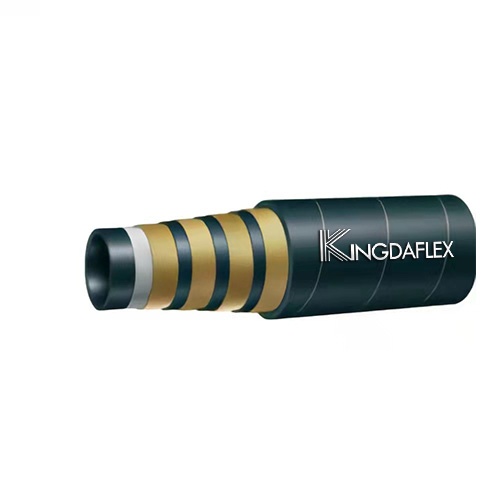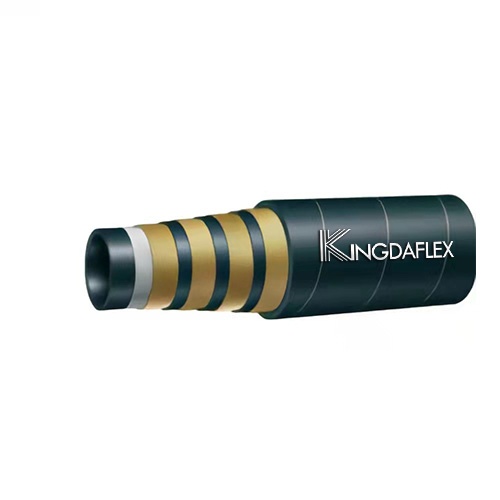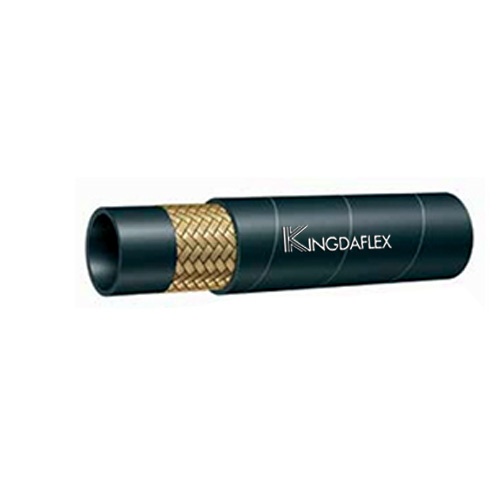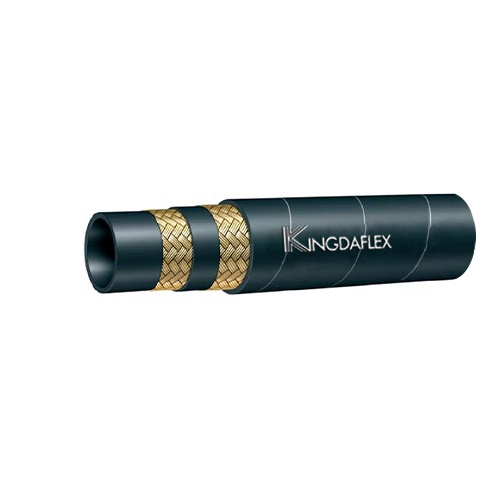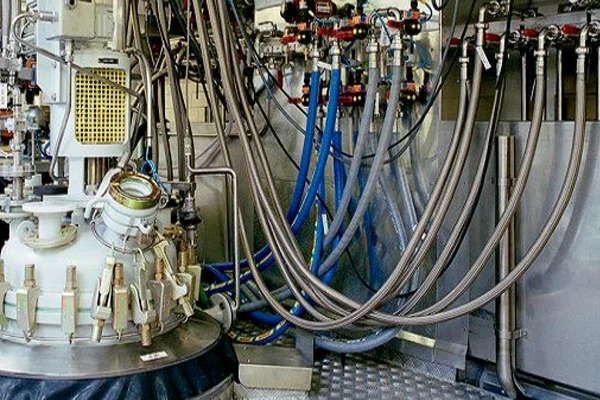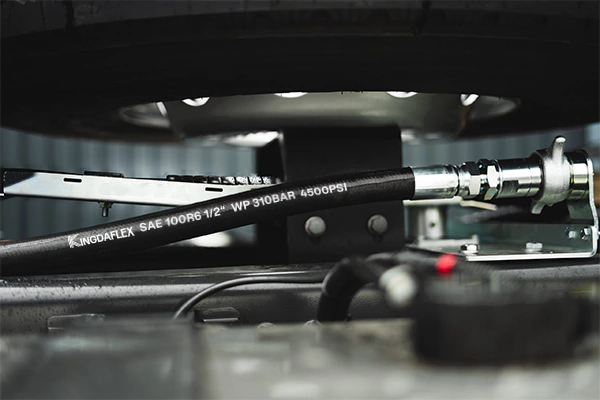Is a damaged hydraulic hose slowing down your operations in Qingdao? You’re not alone; unexpected leaks and ruptures can halt productivity, leading to costly delays and frustration. It’s a common dilemma: do you attempt a quick repair or opt for a complete replacement?
Making the wrong call can lead to repeated failures or unnecessary expenses. This guide will walk you through the critical factors to consider, helping you decide when a hydraulic hose repair is a smart, efficient fix and when a full replacement is the only way to ensure long-term reliability and avoid future headaches.
Why Is Hydraulic Hose Repair Important?
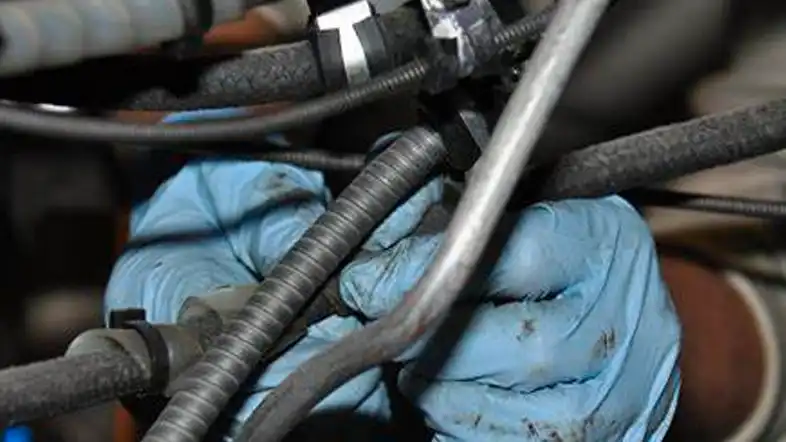
Understanding why hydraulic hose repair is crucial goes beyond simply fixing a leak; it’s about maintaining the operational integrity, safety, and longevity of your machinery here in Qingdao. Neglecting even minor hose damage can lead to a cascade of problems, impacting everything from productivity to the environment.
Prompt and effective repair ensures your equipment runs smoothly, safely, and efficiently, preventing minor issues from escalating into major expenses or dangerous situations.
Here’s why hydraulic hose repair is so important:
- Prevents Costly Downtime: A leaking hose can quickly bring operations to a halt, leading to significant financial losses due to idle equipment and missed deadlines. Prompt repair minimizes these interruptions.
- Enhances Safety: Hydraulic fluid under pressure can cause severe injuries, including injection injuries, if a hose bursts. Leaks also create slip hazards. Timely repairs mitigate these serious safety risks for workers.
- Maintains System Efficiency: Leaks cause a drop in hydraulic pressure, forcing the system to work harder to compensate. This reduces efficiency, increases energy consumption, and can lead to premature wear on other components.
- Extends Equipment Lifespan: Addressing hose issues promptly prevents contamination of the hydraulic fluid and internal damage to pumps, valves, and cylinders, thereby extending the overall lifespan of your machinery.
- Reduces Environmental Impact: Leaking hydraulic fluid is a pollutant. Repairing hoses minimizes spills, reduces environmental contamination, and helps you comply with environmental regulations in Qingdao.
- Saves Money: Repairing a hose is often significantly less expensive than replacing an entire hose assembly or, worse, replacing damaged components downstream due to contamination or pressure loss.
- Prevents Catastrophic Failures: A small leak can quickly escalate into a catastrophic burst, leading to extensive damage to the equipment, surrounding property, or even serious injury. Proactive repair prevents such failures.
Signs of a Leaky Hydraulic Line
Even a small leak in a hydraulic hose can quickly escalate into a major problem, compromising machinery performance, wasting fluid, and creating significant safety hazards. Early detection is key to preventing costly downtime and potential accidents in your Qingdao operations. Knowing what to look for can save you time, money, and even lives.
Keep a watchful eye on your hydraulic systems for these common indicators of a leaking hose. Addressing these signs promptly is crucial for maintaining efficient and safe equipment operation.
Here are the key signs of leaky hydraulic hoses:
- Visible Fluid: The most obvious sign is seeing hydraulic fluid pooling under or dripping from your equipment, hoses, or fittings. Hydraulic fluid is typically amber, reddish, or yellowish, with an oily texture.
- Reduced System Pressure: A noticeable drop in your hydraulic system’s pressure, leading to sluggish performance, reduced lifting capacity, or slower machine response, often points to a leak. You might observe pressure gauge readings below normal operating ranges.
- Unusual Noises: Hissing, whistling, or squealing sounds coming from the hydraulic lines can indicate pressurized fluid or air escaping through a small opening or crack.
- Decreased Fluid Levels: If your hydraulic fluid reservoir requires frequent topping off, it’s a strong indicator of a leak, even if no visible fluid is present.
- Erratic Equipment Movement: Jerky, inconsistent, or unpredictable movements of hydraulic cylinders, motors, or other actuators can be a symptom of insufficient fluid pressure or air in the system due to a leak.
- Strong Hydraulic Oil Smell: A distinct and persistent odor of hydraulic oil around the equipment, even without visible fluid, can signify a leak.
- Increased Operating Temperature: A hydraulic system that is running hotter than usual might be working harder to compensate for a pressure loss caused by a leak, leading to increased friction and heat.
- Visible Wear and Tear on Hoses:
- Cracks, abrasions, or bulges: These visible imperfections on the hose’s outer cover indicate damage and potential points of failure.
- Kinks or twists: Improper routing or excessive bending can stress the hose, weakening it and leading to leaks.
- Exposed reinforcement wire: If the outer cover is worn away, exposing the internal reinforcement layers, the hose is compromised and highly prone to bursting.
How to Repair a Leaking Hydraulic Hose?
Experiencing a hydraulic hose leak? While professional help is always recommended for complex issues, understanding the basics of repair can be invaluable for temporary fixes or minor damage. Here’s a general guide on how to approach a leaking hydraulic hose.
Step 1: Safety First
Before attempting any repair, always prioritize your safety. Hydraulic fluid is under extreme pressure and can cause serious injury. Ensure the equipment is completely powered down, the engine is off, and the hydraulic system is fully depressurized.
Always wear appropriate personal protective equipment (PPE), including safety glasses, gloves, and protective clothing. Confirm that there is no residual pressure in the lines by cycling controls or checking pressure gauges before touching any components.
Step 2: Identify the Leak Source
Carefully inspect the entire length of the hose, including fittings and connections, to pinpoint the exact location of the leak. Look for visible signs like drips, wet spots, or compromised hose material such as cracks, bulges, or abrasions.
Sometimes, a leak might be very small, appearing as a slight seep. If the leak isn’t immediately obvious, you can gently run a piece of cardboard or a clean cloth along the hose to help locate any damp areas.
Step 3: Clean the Area
Once the leak source is identified, thoroughly clean the area around the damage. Use a degreaser or appropriate cleaning solution to remove all hydraulic fluid, dirt, and debris. A clean surface is essential for proper repair.
This step ensures better adhesion for any repair materials and allows for a clearer assessment of the damage. A clean environment also reduces the risk of contaminants entering the hydraulic system during the repair process.
Step 4: Assess the Damage
Evaluate the extent and type of damage to the hose. For minor pinholes or small cuts on the outer cover that haven’t compromised the reinforcement layers, a temporary patch might be feasible. However, any damage that exposes the reinforcement wire or involves a large crack typically requires full hydraulic hose replacement.
Consider the hose’s age, its operating pressure, and the type of fluid it carries. A temporary repair is only suitable for light duty and short-term use. If there’s any doubt about the integrity of the hose, replacement is the safer and more reliable option.
Step 5: Choose Your Repair Method (Temporary)
For very minor leaks, a temporary solution like a high-pressure repair clamp or a specialized self-fusing silicone tape can be used. These methods are designed to provide a seal over the damaged area to prevent further leakage.
Follow the manufacturer’s instructions for the specific repair product you are using. Ensure the repair material is rated for the pressure and temperature of your hydraulic system to avoid immediate failure. This is not a permanent fix.
Step 6: Test the Repair
After applying the temporary repair, slowly and carefully re-pressurize the hydraulic system. Monitor the repaired area closely for any signs of continued leakage. Operate the equipment briefly at a reduced load.
If the leak persists or the repair fails, immediately shut down the system and reconsider a full hose replacement. A successful temporary repair should only buy you time to arrange for a proper, permanent solution.
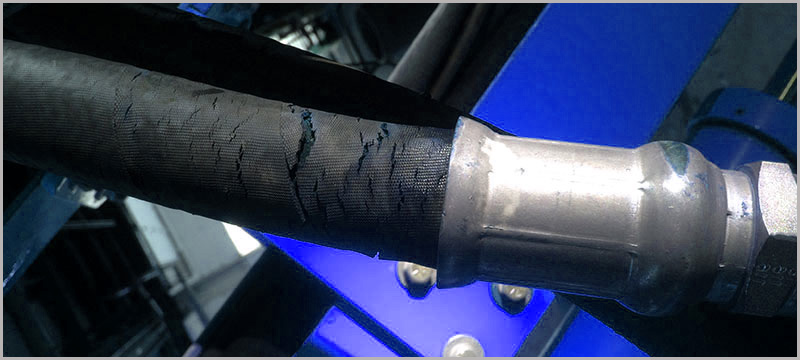
Hydraulic Hose Repair Kit

A hydraulic hose repair kit can be an invaluable asset for any operation that relies on hydraulic machinery, offering a rapid response solution for unexpected hose failures. These kits typically contain a selection of fittings, crimping tools (manual or portable), and sometimes even sections of hose, allowing for on-site repairs that can drastically reduce downtime.
While not a substitute for professional, permanent solutions, having a well-stocked kit readily available enables quick, temporary fixes that keep your equipment running until a full replacement or expert service can be arranged, preventing minor leaks from escalating into major operational disruptions.
Key components and benefits of a hydraulic hose repair kit often include:
- Assorted Fittings: A range of common hydraulic fittings (e.g., JIC, ORFS, NPT) in various sizes to match typical hose ends.
- Hose Sections: Sometimes, kits include short lengths of common hydraulic hose types for splicing or immediate small replacements.
- Crimping Tools: Portable manual or hydraulic crimpers designed for field use, allowing for secure attachment of new fittings to hose segments.
- Cutting Tools: Specialized hose cutters for clean, precise cuts necessary for proper fitting installation.
- Sealing Compounds/Tapes: Items like thread sealant or self-fusing silicone tape for minor, temporary leak containment.
- Gauges/Testers: Some advanced kits might include basic pressure gauges to verify repair integrity.
- Reduced Downtime: Enables immediate, temporary repairs on-site, minimizing the time equipment is out of service.
- Cost-Effectiveness: Avoids the high costs associated with prolonged downtime and emergency service calls.
- Convenience: Provides the necessary tools and components for quick fixes without needing to return to a workshop or wait for specialized service.
- Emergency Preparedness: Essential for operations in remote locations or where immediate access to hydraulic repair services is limited.
Hydraulic Hose Repair Cost
Unexpected hydraulic hose failures can instantly grind your operations to a halt, leaving you with costly downtime and frustrating delays. The immediate concern is always, “How much will this fix set me back?” The truth is, hydraulic hose repair costs vary significantly, influenced by factors like the severity of the damage, the type of hydraulic hose, and whether you opt for a quick patch or a full replacement.
Trying to save a few yuan on a low-quality repair or delaying necessary fixes can lead to far greater expenses down the line. A seemingly cheap patch might fail under pressure, causing more extensive damage to your equipment or even risking safety. Furthermore, prolonged downtime while you source parts or wait for a technician can quickly outweigh any initial savings on the repair itself.
To truly manage the financial impact of hydraulic hose issues, consider the long-term value of reliable solutions. Investing in Kingdaflex hydraulic hoses and professional repair or replacement services, even if the upfront cost seems higher, often proves more economical. This approach minimizes recurring problems, reduces future downtime, and ensures the safety and longevity of your valuable machinery.
Identify the Right Hydraulic Hose
Related: How to Install Hydraulic Hose? [Hydraulic Hose Installation Tips]
Repair Hydraulic Hose With Tape
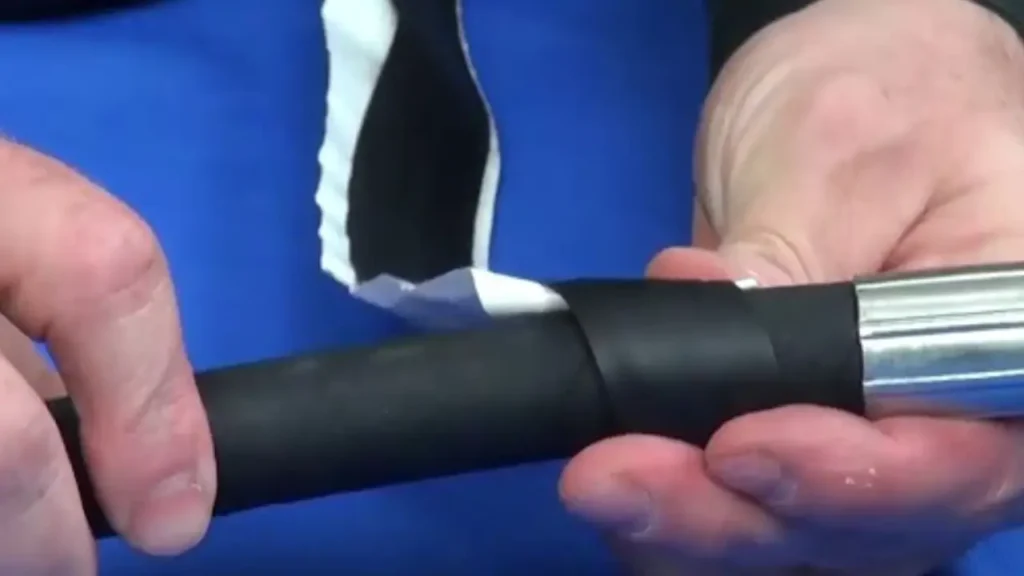
Using tape to repair a leaking hydraulic hose should generally only be considered an absolute last resort, a very temporary measure to get out of an emergency situation.
Hydraulic systems operate under extremely high pressures, and most tapes are simply not designed to withstand such forces reliably. This approach is not a permanent or safe solution.
Step 1: Safety First and System Depressurization
Prioritize safety by ensuring the equipment is completely shut down and the hydraulic system is fully depressurized. Hydraulic fluid under pressure can cause severe injection injuries. Wear appropriate PPE, including safety glasses and gloves, to protect yourself from escaping fluid.
Confirm no residual pressure remains in the lines by cycling controls or observing pressure gauges. This critical step prevents unexpected fluid release and potential harm during the temporary repair attempt.
Step 2: Clean and Prepare the Hose
Thoroughly clean the area around the leak on the hydraulic hose. Remove all dirt, grease, and hydraulic fluid using a degreaser or appropriate cleaner. A clean and dry surface is essential for any tape to have a chance of adhering, even temporarily.
Ensure the hose is completely dry before proceeding. Any moisture will significantly compromise the tape’s ability to stick, rendering the temporary repair ineffective and potentially dangerous under pressure.
Step 3: Apply the Tape Tightly
For this emergency fix, specialized self-fusing silicone tape is generally the most effective type, as it bonds to itself creating a tighter seal than standard tapes. Start wrapping the tape several inches before the leak, overlapping each turn by at least half the width of the tape.
Wrap the tape very tightly and consistently, extending several inches beyond the leak. The goal is to build up multiple layers to create a temporary barrier against the high pressure, but understand this is still a very fragile and unreliable fix.
Step 4: Monitor and Plan for Permanent Repair
After applying the tape, carefully and slowly re-pressurize the hydraulic system while closely monitoring the taped area for any continued leakage or signs of failure. Do not operate the equipment under full load with a taped hose.
This tape repair is strictly a temporary measure to move equipment to a safe location or finish a critical task. Immediately plan for a proper, permanent repair, which involves replacing the damaged hose with a new, correctly rated hydraulic hose from a reputable supplier like Kingdaflex.
Can a High Pressure Hydraulic Hose Be Repaired?
A sudden failure in a high-pressure hydraulic hose can bring your critical operations in Qingdao to a screeching halt, leading to significant downtime and potential safety risks. When faced with such a scenario, the immediate question often arises: can this highly stressed component truly be repaired, or is full replacement the only viable option? Attempting an improper or unsafe repair on a high-pressure hose isn’t just ineffective; it can lead to catastrophic bursts, causing severe injury, extensive equipment damage, and further costly delays.
While minor, temporary fixes might sometimes be possible in emergency situations, the inherent dangers and extreme forces involved in high-pressure hydraulic systems mean that a true, permanent “repair” in the sense of patching a compromise in the hose itself is generally not recommended by industry standards.
For true reliability and safety, especially with Kingdaflex high-pressure hydraulic hoses, the best practice is almost always a complete replacement of the damaged hose assembly. This ensures the integrity of the entire system, preventing future failures, safeguarding personnel, and guaranteeing the long-term performance of your machinery.
Conclusion
Navigating hydraulic hose issues can be a challenge, but understanding the signs and making an informed decision—whether to repair or replace—is crucial for operational efficiency and safety in Qingdao. Prioritize regular inspections and always err on the side of caution when dealing with critical components.
Don’t let guesswork lead to further downtime or dangerous situations. For reliable, high-quality hydraulic hoses and expert advice, turn to a trusted supplier.
Ensure your machinery keeps running optimally by sourcing wholesale directly from our Kingdaflex hydraulic hose manufacturer. We provide the durable, dependable solutions you need to minimize interruptions and maximize productivity.

